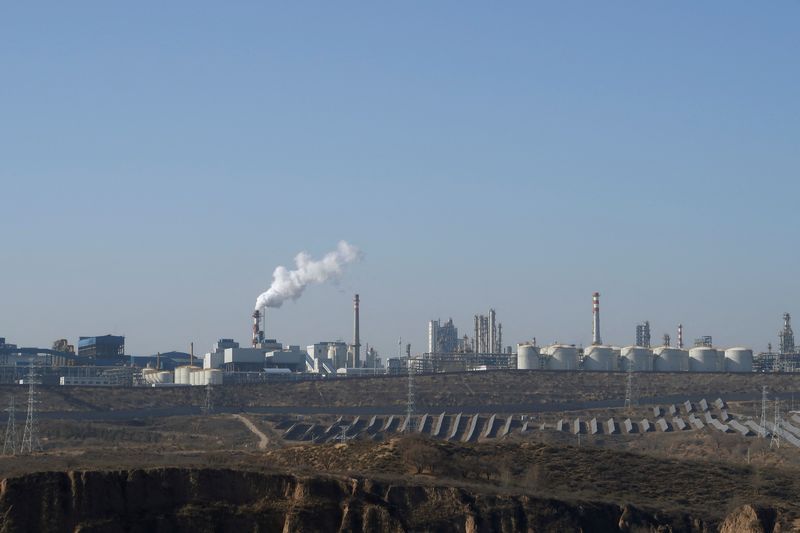China's emissions, efficiency targets under threat after falling short in 2023

Source: Market Screener
SINGAPORE, March 12 (Reuters) - China is falling short on key targets for tackling climate-warming emissions, and analysts said Beijing's credibility in global climate talks could be at risk unless it redoubles its efforts to get back on track.
The Chinese government has rarely missed targets in the past. But now, driven primarily by energy security concerns, it has shown little political will to address the emissions gap, analysts said.
China's National Development and Reform Commission (NDRC), a planning agency, promised last week to "redouble efforts in energy conservation and carbon reduction" this year after it "fell short of expectations" in 2023.
Analysts say it is well behind on its goal to slash energy intensity by 13.5% and carbon intensity by 18% between 2021 and 2025.
The intensity rates - measuring how much energy is consumed and how much carbon dioxide emitted per unit of economic growth - are a key part of the country's pledge to bring emissions to a peak before 2030 and to net zero by 2060.
Keeping its targets within reach would require "concerted efforts across all sectors to bridge the gap", said Jom Madan, senior research analyst with the consultancy Wood Mackenzie.
But the planning commission set targets for 2024 that fall far short of what is needed. For energy intensity, the commission mandated only a 2.5% reduction. It set no new target for carbon intensity, and made no new moves to curb the use of coal - the most polluting fossil fuel.
Madan predicted that China might "come close ... but not quite achieve its targets" on energy efficiency. If the country misses its 2025 targets, it could raise doubts worldwide about its ability to rein in emissions.
The country also risks a "serious loss of diplomatic credibility," said lead analyst Lauri Myllyvirta of the Centre for Research on Energy and Clean Air.
"China has long emphasised its ability to implement the country's commitments, while criticising others for setting lofty targets," he said.
The NDRC did not respond to a request for comment.
As the world's biggest carbon polluter and second-largest economy, China has faced growing international pressure to show more climate ambition. It has resisted, arguing that it is already doing more than most fast-developing countries.
China's rising emissions account for 35% of the world's annual total. On a per capita basis, the emissions level is 15% higher per capita than the OECD average, the International Energy Agency said last week.
To meet its goals, Beijing should focus on efficiency improvements in industry and construction, and offer more financial support for companies to replace or retrofit outdated facilities, Madan said. Expanding the carbon market would also help, he added.
Officially, China's energy intensity fell 0.5% in 2023, the country's statistics bureau said last month, missing a 2% target.
The gap would have been worse, but China last month removed non-fossil fuels such as nuclear and renewable energy from the equation to focus on tackling fossil fuels. China is applying this definition retroactively, Myllyvirta said. Without the change, the energy intensity calculation would have shown an increase of 0.5%.
Myllyvirta estimated that China would need to cut energy intensity by 6% in 2024 and 2025 to meet the 2021-2025 target - far higher than the 2.5% goal set this week.
Energy intensity might matter less in the future, however, said Ma Jun, director of the Beijing-based Institute of Public and Environmental Affairs. The change in how it is calculated "reflects a new reality" for China, in which economic growth is increasingly driven by the renewables sector, and fossil-fuel dependent industries will come under more pressure to boost efficiency, Ma said.
"That means carbon intensity is going to matter more," he said.
Although China set no new targets for carbon intensity, the country's economic growth implies the measure will fall about 3% this year, analysts said.
However, after dropping 4.6% from 2020 to 2023, carbon intensity would need to drop about 7% this year and next to reach the 2025 goal, Myllyvirta said.
Missing climate targets is unusual for China, which has made job promotions contingent on environmental progress to encourage workers and agencies to meet goals.
In 2022, China's corruption watchdog warned that some regions were providing fraudulent energy and carbon intensity figures that were overly positive.
Pressure to comply with intensity targets also caused economic disruptions in 2010, with provinces cutting power supplies to energy-intensive industries and forcing homes to ration electricity.
Without a major boost to its climate efforts now, "meeting the five-year intensity targets by 2025 will be very challenging," said Li Shuo, director of the China Climate Hub at the Asia Society Policy Institute in Washington.
"This year's government work report certainly did not signal that level of decisiveness," Shou said. (Editing by Katy Daigle and Gerry Doyle)
